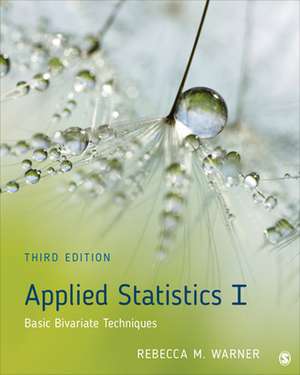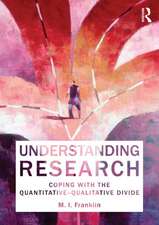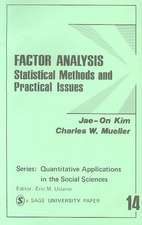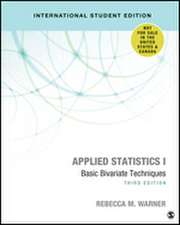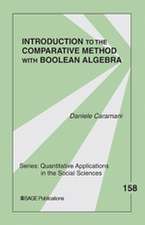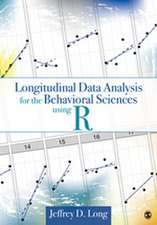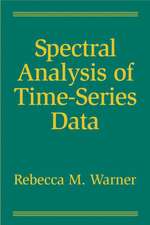Applied Statistics I: Basic Bivariate Techniques
Autor Rebecca M. Warneren Limba Engleză Paperback – 13 apr 2020
Preț: 931.90 lei
Preț vechi: 1210.25 lei
-23% Nou
Puncte Express: 1398
Preț estimativ în valută:
178.33€ • 187.04$ • 148.45£
178.33€ • 187.04$ • 148.45£
Carte disponibilă
Livrare economică 11-25 martie
Preluare comenzi: 021 569.72.76
Specificații
ISBN-13: 9781506352800
ISBN-10: 1506352804
Pagini: 632
Dimensiuni: 203 x 254 mm
Greutate: 0.98 kg
Ediția:Third Edition
Editura: SAGE Publications
Colecția Sage Publications, Inc
Locul publicării:Thousand Oaks, United States
ISBN-10: 1506352804
Pagini: 632
Dimensiuni: 203 x 254 mm
Greutate: 0.98 kg
Ediția:Third Edition
Editura: SAGE Publications
Colecția Sage Publications, Inc
Locul publicării:Thousand Oaks, United States
Cuprins
1.
Evaluating
Numeric
Information
Introduction
Guidelines for Numeracy
Source Credibility
Message Content
Evaluating Generalizability
Making Causal Claims
Quality Control Mechanisms in Science
Biases of Information Consumers
Ethical Issues in Data Collection and Analysis
Lying with Graphs and Statistics
Degrees of Belief
Summary
2. Basic Research Concepts
Introduction
Types of Variables
Independent and Dependent Variables
Typical Research Questions
Conditions for Causal Inference
Experimental Research Design
Non-experimental Research Design
Quasi- Experimental Designs
Other Issues in Design and Analysis
Choice of Statistical Analysis (Preview)
Populations and Samples: Ideal Versus Actual Situations
Common Problems in Interpretation of Results
Appendix 2 A: More About Levels of Measurement
Appendix 2 B: Justification for Use of Likert and Other Rating Scales as Quantitative Variables (In Some Situations)
3. Frequency Distribution Tables
Introduction
Use of Frequency Tables for Data Screening
Frequency Tables for Categorical Variables
Elements of Frequency Tables
Using SPSS to Obtain a Frequency Table
Mode, Impossible Score Values, and Missing Values
Reporting Data Screening for Categorical Variables
Frequency Tables for Quantitative Variables
Frequency Tables for Categorical Versus Quantitative Variables
Reporting Data Screening for Quantitative Variables
What We Hope to See in Frequency Tables for Categorical Variables
What We Hope to See in Frequency Tables for Quantitative Variables
Summary
Appendix 3 A: Getting Started in IBM SPSS ® version 25
Appendix 3 B: Missing Values in Frequency Tables
Appendix 3 C: Dividing Scores into Groups or Bins
4. Descriptive Statistics
Introduction
Questions about Quantitative Variables
Notation
Sample Median
Sample Mean (M)
An Important Characteristic of M: Sum of Deviations from M = 0
Disadvantage of M: It is Not Robust Against Influence of Extreme Scores
Behavior of Mean, Median and Mode in Common Real-World Situations
Choosing Among Mean, Median, and Mode
Using SPSS to Obtain Descriptive Statistics for a Quantitative Variable
Minimum, Maximum, and Range: Variation among Scores
The Sample Variance s2
Sample Standard Deviation (s or SD)
How a Standard Deviation Describes Variation Among Scores in a Frequency Table
Why Is There Variance?
Reports of Descriptive Statistics in Journal Articles
Additional Issues in Reporting Descriptive Statistics
Summary
Appendix 4 A Order of Arithmetic Operations
Appendix 4 B Rounding
5. Graphs: Bar Charts, Histograms, and Box Plots
Introduction
Pie Charts for Categorical Variables
Bar Charts for Frequencies of Categorical Variables
Good Practice for Construction of Bar Charts
Deceptive Bar Graphs
Histograms for Quantitative Variables
Obtaining a Histogram Using SPSS
Describing and Sketching Bell-Shaped Distributions
Good Practices in Setting up Histograms
Box Plot (Box and Whiskers Plot)
Telling Stories About Distributions
Uses of Graphs in Actual Research
Data Screening: Separate Bar Charts or Histograms for Groups
Use of Bar Charts to Represent Group Means
Other Examples
Summary
6. The Normal Distribution and z Scores
Introduction
Locations of Individual Scores in Normal Distributions
Standardized or “z” Scores
Converting z Scores Back into Original Units of X
Understanding Values of z
Qualitative Description of Normal Distribution Shape
More Precise Description of Normal Distribution Shape
Reading Tables of Areas for the Standard Normal Distribution
Dividing the Normal Distribution Into Three Regions: Lower Tail, Middle, Upper Tail
Outliers Relative to a Normal Distribution
Summary of First Part of Chapter
Why We Assess Distribution Shape
Departure from Normality: Skewness
Another Departure from Normality: Kurtosis
Overall Normality
Practical Recommendations
Reporting Information About Distribution Shape, Missing Values, Outliers, and Descriptive Statistics for Quantitative Variables
Summary
Appendix 6 A: The Mathematics of the Normal Distribution
Appendix 6 B: How to Select and Remove Outliers in SPSS
Appendix 6 C: Quantitative Assessments of Departure from Normality
Appendix 6 D: Why Are Some Real-World Variables Approximately Normally Distributed?
7. Sampling Error and Confidence Intervals
Descriptive Versus Inferential Uses of Statistics
Notations for Samples Versus Populations
Sampling Error and the Sampling Distribution for Values of M
Prediction Error
Sample Versus Population (Revisited)
The Central Limit Theorem: Characteristics of the Sampling Distribution of M
Factors that Influence Population Standard Error
Effect of N on Value of the Population Standard Error
Describing the Location of a Single Outcome for M Relative to a Population Sampling Distribution (Setting Up a z Ratio)
What We Do When ?? Is Unknown
The Family of t Distributions
Tables for t Distributions
Using Sampling Error to Set Up a Confidence Interval
How to Interpret a Confidence Interval
Empirical Example: Confidence Interval for Body Temperature
Other Applications for CIs
Error Bars in Graphs of Group Means
Summary
8. The One-Sample t test: Introduction to Statistical Significance Tests
Introduction
Significance Tests as Yes/No Questions About Proposed Values of Population Means
Stating a Null Hypothesis
Selecting an Alternative Hypothesis
The One-Sample t Test
Choosing an Alpha (?) Level
Specifying Reject Regions Based on ?, Halt and df
Questions for the One-Sample t Test
Assumptions for the Use of the One-Sample t Test
Rules for the Use of NHST
First Example: Mean Driving Speed (Nondirectional Test)
SPSS Analysis: One Sample t Test for Mean Driving Speed
“Exact” p Values
Reporting Results for a Two-tailed One-Sample t Test
The Driving Speed Data Reconsidered Using a One-Tailed Test
Reporting Results for a One-tailed One-Sample t Test:
Advantages/ Disadvantages of One Tailed Tests
Traditional NHST Versus New Statistics Recommendations
Things You Should Not Say About p Values
Summary
9. Issues in Significance Tests: Effect Size, Statistical Power, and Decision Errors
Beyond p Values
Cohen’s d: An Effect Size Index
Factors that Affect the Size of t Ratios
Statistical Significance Versus Practical Importance
Statistical Power
Type I and Type II Decision Errors
Meanings of “Error”
Use of NHST in Exploratory Versus Confirmatory Research
Inflated Risk of Type I Error From Multiple Tests Interpretation of Null Outcomes
Interpretation of Null Outcomes
Interpretation of Statistically Significant Outcomes
Understanding Past Research
Planning Future Research
Guidelines for Reporting Results
What You Cannot Say
Summary
Appendix 9 A Further Explanation of Statistical Power
10. Bivariate Pearson Correlation
Research Situations Where Pearson r Is Used
Correlation and Causal Inference
How Sign and Magnitude of r Describe an X, Y Relationship
Setting Up Scatter Plots With Examples of Perfect Linearity
Most Associations Are Not Perfect
Different Situations In Which r = 0
Assumptions for Use of Pearson r
Preliminary Data Screening for Pearson r
Effect of Extreme Bivariate Outliers
Research Example
Data Screening for Research Example
Computation of Pearson r
How Computation for Correlation Is Related to Pattern of Data Points in the Scatter Plot
Testing the Hypothesis That ?0 = 0
Reporting Many Correlations and Inflated Risk of Type I Error
Obtaining CIs for Correlations
Pearson’s r and r2 as Effect-Size Indexes and Partition of Variance
Statistical Power and Sample Size for Correlation Studies
Interpretation of Outcomes for Pearson’s r
SPSS Example
Results Sections for One and Several Pearson r Values
Reasons to Be Skeptical of Correlations
Summary
Appendix 10 A: Nonparametric Alternatives to Pearson r
Appendix 10 B: Setting Up a 95% CI for Pearson r
Appendix 10 C: Testing Significance of Differences Between Correlations
Appendix 10 D: Factors That Artifactually Influence the Magnitude of Pearson’s r
Appendix 10 E: Analysis of Non Linear Relationships
11. Bivariate Regression
Research Situations Where Bivariate Regression is Used
New Information Provided by Regression
Regression Equations and Lines
Two Versions of Regression Equations
Steps in Regression Analysis
Preliminary Data Screening
Formulas for Bivariate Regression Coefficients
Statistical Significance Tests for Bivariate Regression
Confidence Intervals for Regression Coefficients
Effect Size and Statistical Power
Empirical Example Using SPSS: Salary Data
SPSS Output: Salary Data
Plotting the Regression Line: Salary Data
Results Section: Salary Data
Using Regression Equation to Predict Score for Individual: Joe’s Hr Data
Partition of SS in Bivariate Regression: Joe’s Hr Data
Issues in Planning a Bivariate Regression Study
Plotting Residuals
Standard Error of the Estimate, sy.x
Summary
Appendix 11 A OLS Derivation of Equation for Regression Coefficients
Appendix 11 B Fully Worked Example for SS values: Joe’s HR Data
12. The Independent Samples t Test
Research Situations Where the Independent Samples t Test is Used
Hypothetical Research Example
Assumptions for Use of the Independent Samples t Test
Preliminary Data Screening: Evaluating Violations of Assumptions and Getting to Know Your Data
Computation of Independent Samples t Test
Statistical Significance of Independent Samples t Test
Confidence Interval Around (M1 – M2)
SPSS Commands for Independent Samples t Test
SPSS Output for Independent Samples t Test
Effect-Size Indexes for t
Factors that Influence the Size of t
Results Section
Graphing Results: Means and CIs
Decisions About Sample Size for the Independent Samples t Test
Issues in Designing a Study
Summary
Appendix 12 A: A Nonparametric Alternative to the Independent Samples t Test
13. One-Way Between-S Analysis of Variance
Research Situations Where Between-S One-Way ANOVA is Used
Questions in One-Way Between S ANOVA
Hypothetical Research Example
Assumptions and Data Screening for One-Way ANOVA
Computations for One-Way Between-S ANOVA
Patterns of Scores and Magnitudes of SSbetween and SSwithin
Confidence Intervals (CIs) For Group Means
Effect Sizes for One-Way Between-S ANOVA
Statistical Power Analysis for One-Way Between-S ANOVA
Planned Contrasts
Post Hoc or “Protected” Tests
One Way Between S ANOVA Procedure in SPSS
Output from SPSS for One Way Between S ANOVA
Reporting Results from One Way Between S ANOVA
Issues in Planning a Study
Summary
Appendix A ANOVA Model and Division of Scores Into Components
Appendix B Expected Value of F When H0 is True
Appendix C Comparison of ANOVA to t Test
Appendix D Nonparametric Alternative to One Way Between S ANOVA
14. Paired Samples t-Test
Independent Versus Paired Samples Designs
Between-S and Within-S or Paired Groups Designs
Types of Paired Samples
Hypothetical Study: Effects of Stress on Heart Rate
Review: Data Organization for Independent Samples
New: Data Organization for Paired Samples
A First Look at Repeated Measures Data
Calculation of Difference (d) Scores
Null Hypothesis for Paired Samples t Test
Assumptions for Paired Samples t Test
Formulas for Paired Samples t Test
SPSS Paired Samples t Test Procedure
Comparison of Results For Independent Samples t and Paired Samples t Tests
Effect Size and Power
Some Design Problems in Repeated Measures Designs
Results for Paired Samples t-Test: Stress and HR
Further Evaluation of Assumptions for Larger Dataset
Summary
Appendix A Nonparametric Alternative to Paired Samples t: Wilcoxon Signed Rank Test
15. One Way Repeated Measures ANOVA
Introduction
Null Hypothesis for Repeated Measures ANOVA
Preliminary Assessment of Repeated Measures Data
Computations for One-Way Repeated Measures ANOVA
Use of SPSS Reliability Procedure for One Way Repeated Measures ANOVA
Partition of SS in Between-S Versus Within-S ANOVA
Assumptions for Repeated Measures ANOVA
Choices of Contrasts in GLM Repeated Measures
SPSS GLM Procedure for Repeated Measures ANOVA
Output for GLM Repeated Measures ANOVA
Paired Samples t Tests as Follow Up
Results
Effect Size
Statistical Power
Counterbalancing in Repeated Measures Studies
More Complex Designs
Summary
Appendix 15 A Test for Person by Treatment Interaction
16. Factorial Analysis of Variance (Between – S)
Research Situations Where Factorial Design Is Used
Questions in Factorial ANOVA
Null Hypotheses in Factorial ANOVA
Screening for Violations of Assumptions
Hypothetical Research Situation
Computations for Between-S Factorial ANOVA
Computation of SS, df, and MS in Two Way Factorial
Effect Size Estimates for Factorial ANOVA
Statistical Power
Follow-Up Tests
Factorial ANOVA Using the SPSS GLM Procedure
SPSS Output
Results
Design Decisions and Magnitudes of SS Terms
Summary
Appendix 16 A: Unequal Cell ns in Factorial ANOVA
Appendix 16 B: Weighted Versus Unweighted Means
Appendix 16 C: Model for Factorial ANOVA
Appendix 16 D: Fixed Versus Random Factors
17. Chi Square Analysis of Contingency Tables
Evaluating Association Between Two Categorical Variables
First Example: Contingency Tables for Titanic Data
What is Contingency?
Conditional and Unconditional Probabilities
Null Hypothesis for Contingency Table Analysis
Second Empirical Example: Dog Ownership Data
Preliminary Examination of Dog Ownership Data
Expected Cell Frequencies If H0 True
Computation of Chi Squared Significance Test
Evaluation of Statistical Significance of ?2.
Effect Sizes for Chi Squared
Chi Squared Example Using SPSS
Output from Crosstabs Procedure
Reporting Results
Assumptions and Data Screening For Contingency Tables
Other Measures of Association for Contingency Tables
Summary
Appendix 17 A: Margin of Error For Percentages in Surveys
Appendix 17 B: Contingency Tables With Repeated Measures: McNemar Test
Appendix 17 C: Fisher Exact Test
Appendix 17 D: How Marginal Distributions for X and Y Constrain Maximum Value of ??
Appendix 17 E: Other Uses of ?2
18. Selection of Bivariate Analyses and Review of Key Concepts
Selecting Appropriate Bivariate Analyses
Types of Independent and Dependent Variables (Categorical Versus Quantitative)
Parametric Versus Nonparametric Analyses
Comparisons of Means or Medians Across Groups (Categorical IV and Quantitative DV)
Problems with Selective Reporting of Evidence and Analyses
Limitations of Statistical Significance Tests and p Values
Statistical Versus Practical Significance
Generalizability Issues
Causal Inference
Results Sections
Beyond Bivariate Analyses: Adding Variables
Some Multivariable or Multivariate Analyses
Degrees of Belief
19. Chi Square Analysis of Contingency Tables
Evaluating Association Between Two Categorical Variables
First Example: Contingency Tables for Titanic Data
What is Contingency?
Conditional and Unconditional Probabilities
Null Hypothesis for Contingency Table Analysis
Second Empirical Example: Dog Ownership Data
Preliminary Examination of Dog Ownership Data
Expected Cell Frequencies If H0 True
Computation of Chi Squared Significance Test
Evaluation of Statistical Significance of ?2.
Effect Sizes for Chi Squared
Chi Squared Example Using SPSS
Output from Crosstabs Procedure
Reporting Results
Assumptions and Data Screening For Contingency Tables
Other Measures of Association for Contingency Tables
Summary
Appendix 17 A: Margin of Error For Percentages in Surveys
Appendix 17 B: Contingency Tables With Repeated Measures: McNemar Test
Appendix 17 C: Fisher Exact Test
Appendix 17 D: How Marginal Distributions for X and Y Constrain Maximum Value of ??
Appendix 17 E: Other Uses of ?2
20. Selection of Bivariate Analyses and Review of Key Concepts
Selecting Appropriate Bivariate Analyses
Types of Independent and Dependent Variables (Categorical Versus Quantitative)
Parametric Versus Nonparametric Analyses
Comparisons of Means or Medians Across Groups (Categorical IV and Quantitative DV)
Problems with Selective Reporting of Evidence and Analyses
Limitations of Statistical Significance Tests and p Values
Statistical Versus Practical Significance
Generalizability Issues
Causal Inference
Results Sections
Beyond Bivariate Analyses: Adding Variables
Some Multivariable or Multivariate Analyses
Degrees of Belief
Introduction
Guidelines for Numeracy
Source Credibility
Message Content
Evaluating Generalizability
Making Causal Claims
Quality Control Mechanisms in Science
Biases of Information Consumers
Ethical Issues in Data Collection and Analysis
Lying with Graphs and Statistics
Degrees of Belief
Summary
2. Basic Research Concepts
Introduction
Types of Variables
Independent and Dependent Variables
Typical Research Questions
Conditions for Causal Inference
Experimental Research Design
Non-experimental Research Design
Quasi- Experimental Designs
Other Issues in Design and Analysis
Choice of Statistical Analysis (Preview)
Populations and Samples: Ideal Versus Actual Situations
Common Problems in Interpretation of Results
Appendix 2 A: More About Levels of Measurement
Appendix 2 B: Justification for Use of Likert and Other Rating Scales as Quantitative Variables (In Some Situations)
3. Frequency Distribution Tables
Introduction
Use of Frequency Tables for Data Screening
Frequency Tables for Categorical Variables
Elements of Frequency Tables
Using SPSS to Obtain a Frequency Table
Mode, Impossible Score Values, and Missing Values
Reporting Data Screening for Categorical Variables
Frequency Tables for Quantitative Variables
Frequency Tables for Categorical Versus Quantitative Variables
Reporting Data Screening for Quantitative Variables
What We Hope to See in Frequency Tables for Categorical Variables
What We Hope to See in Frequency Tables for Quantitative Variables
Summary
Appendix 3 A: Getting Started in IBM SPSS ® version 25
Appendix 3 B: Missing Values in Frequency Tables
Appendix 3 C: Dividing Scores into Groups or Bins
4. Descriptive Statistics
Introduction
Questions about Quantitative Variables
Notation
Sample Median
Sample Mean (M)
An Important Characteristic of M: Sum of Deviations from M = 0
Disadvantage of M: It is Not Robust Against Influence of Extreme Scores
Behavior of Mean, Median and Mode in Common Real-World Situations
Choosing Among Mean, Median, and Mode
Using SPSS to Obtain Descriptive Statistics for a Quantitative Variable
Minimum, Maximum, and Range: Variation among Scores
The Sample Variance s2
Sample Standard Deviation (s or SD)
How a Standard Deviation Describes Variation Among Scores in a Frequency Table
Why Is There Variance?
Reports of Descriptive Statistics in Journal Articles
Additional Issues in Reporting Descriptive Statistics
Summary
Appendix 4 A Order of Arithmetic Operations
Appendix 4 B Rounding
5. Graphs: Bar Charts, Histograms, and Box Plots
Introduction
Pie Charts for Categorical Variables
Bar Charts for Frequencies of Categorical Variables
Good Practice for Construction of Bar Charts
Deceptive Bar Graphs
Histograms for Quantitative Variables
Obtaining a Histogram Using SPSS
Describing and Sketching Bell-Shaped Distributions
Good Practices in Setting up Histograms
Box Plot (Box and Whiskers Plot)
Telling Stories About Distributions
Uses of Graphs in Actual Research
Data Screening: Separate Bar Charts or Histograms for Groups
Use of Bar Charts to Represent Group Means
Other Examples
Summary
6. The Normal Distribution and z Scores
Introduction
Locations of Individual Scores in Normal Distributions
Standardized or “z” Scores
Converting z Scores Back into Original Units of X
Understanding Values of z
Qualitative Description of Normal Distribution Shape
More Precise Description of Normal Distribution Shape
Reading Tables of Areas for the Standard Normal Distribution
Dividing the Normal Distribution Into Three Regions: Lower Tail, Middle, Upper Tail
Outliers Relative to a Normal Distribution
Summary of First Part of Chapter
Why We Assess Distribution Shape
Departure from Normality: Skewness
Another Departure from Normality: Kurtosis
Overall Normality
Practical Recommendations
Reporting Information About Distribution Shape, Missing Values, Outliers, and Descriptive Statistics for Quantitative Variables
Summary
Appendix 6 A: The Mathematics of the Normal Distribution
Appendix 6 B: How to Select and Remove Outliers in SPSS
Appendix 6 C: Quantitative Assessments of Departure from Normality
Appendix 6 D: Why Are Some Real-World Variables Approximately Normally Distributed?
7. Sampling Error and Confidence Intervals
Descriptive Versus Inferential Uses of Statistics
Notations for Samples Versus Populations
Sampling Error and the Sampling Distribution for Values of M
Prediction Error
Sample Versus Population (Revisited)
The Central Limit Theorem: Characteristics of the Sampling Distribution of M
Factors that Influence Population Standard Error
Effect of N on Value of the Population Standard Error
Describing the Location of a Single Outcome for M Relative to a Population Sampling Distribution (Setting Up a z Ratio)
What We Do When ?? Is Unknown
The Family of t Distributions
Tables for t Distributions
Using Sampling Error to Set Up a Confidence Interval
How to Interpret a Confidence Interval
Empirical Example: Confidence Interval for Body Temperature
Other Applications for CIs
Error Bars in Graphs of Group Means
Summary
8. The One-Sample t test: Introduction to Statistical Significance Tests
Introduction
Significance Tests as Yes/No Questions About Proposed Values of Population Means
Stating a Null Hypothesis
Selecting an Alternative Hypothesis
The One-Sample t Test
Choosing an Alpha (?) Level
Specifying Reject Regions Based on ?, Halt and df
Questions for the One-Sample t Test
Assumptions for the Use of the One-Sample t Test
Rules for the Use of NHST
First Example: Mean Driving Speed (Nondirectional Test)
SPSS Analysis: One Sample t Test for Mean Driving Speed
“Exact” p Values
Reporting Results for a Two-tailed One-Sample t Test
The Driving Speed Data Reconsidered Using a One-Tailed Test
Reporting Results for a One-tailed One-Sample t Test:
Advantages/ Disadvantages of One Tailed Tests
Traditional NHST Versus New Statistics Recommendations
Things You Should Not Say About p Values
Summary
9. Issues in Significance Tests: Effect Size, Statistical Power, and Decision Errors
Beyond p Values
Cohen’s d: An Effect Size Index
Factors that Affect the Size of t Ratios
Statistical Significance Versus Practical Importance
Statistical Power
Type I and Type II Decision Errors
Meanings of “Error”
Use of NHST in Exploratory Versus Confirmatory Research
Inflated Risk of Type I Error From Multiple Tests Interpretation of Null Outcomes
Interpretation of Null Outcomes
Interpretation of Statistically Significant Outcomes
Understanding Past Research
Planning Future Research
Guidelines for Reporting Results
What You Cannot Say
Summary
Appendix 9 A Further Explanation of Statistical Power
10. Bivariate Pearson Correlation
Research Situations Where Pearson r Is Used
Correlation and Causal Inference
How Sign and Magnitude of r Describe an X, Y Relationship
Setting Up Scatter Plots With Examples of Perfect Linearity
Most Associations Are Not Perfect
Different Situations In Which r = 0
Assumptions for Use of Pearson r
Preliminary Data Screening for Pearson r
Effect of Extreme Bivariate Outliers
Research Example
Data Screening for Research Example
Computation of Pearson r
How Computation for Correlation Is Related to Pattern of Data Points in the Scatter Plot
Testing the Hypothesis That ?0 = 0
Reporting Many Correlations and Inflated Risk of Type I Error
Obtaining CIs for Correlations
Pearson’s r and r2 as Effect-Size Indexes and Partition of Variance
Statistical Power and Sample Size for Correlation Studies
Interpretation of Outcomes for Pearson’s r
SPSS Example
Results Sections for One and Several Pearson r Values
Reasons to Be Skeptical of Correlations
Summary
Appendix 10 A: Nonparametric Alternatives to Pearson r
Appendix 10 B: Setting Up a 95% CI for Pearson r
Appendix 10 C: Testing Significance of Differences Between Correlations
Appendix 10 D: Factors That Artifactually Influence the Magnitude of Pearson’s r
Appendix 10 E: Analysis of Non Linear Relationships
11. Bivariate Regression
Research Situations Where Bivariate Regression is Used
New Information Provided by Regression
Regression Equations and Lines
Two Versions of Regression Equations
Steps in Regression Analysis
Preliminary Data Screening
Formulas for Bivariate Regression Coefficients
Statistical Significance Tests for Bivariate Regression
Confidence Intervals for Regression Coefficients
Effect Size and Statistical Power
Empirical Example Using SPSS: Salary Data
SPSS Output: Salary Data
Plotting the Regression Line: Salary Data
Results Section: Salary Data
Using Regression Equation to Predict Score for Individual: Joe’s Hr Data
Partition of SS in Bivariate Regression: Joe’s Hr Data
Issues in Planning a Bivariate Regression Study
Plotting Residuals
Standard Error of the Estimate, sy.x
Summary
Appendix 11 A OLS Derivation of Equation for Regression Coefficients
Appendix 11 B Fully Worked Example for SS values: Joe’s HR Data
12. The Independent Samples t Test
Research Situations Where the Independent Samples t Test is Used
Hypothetical Research Example
Assumptions for Use of the Independent Samples t Test
Preliminary Data Screening: Evaluating Violations of Assumptions and Getting to Know Your Data
Computation of Independent Samples t Test
Statistical Significance of Independent Samples t Test
Confidence Interval Around (M1 – M2)
SPSS Commands for Independent Samples t Test
SPSS Output for Independent Samples t Test
Effect-Size Indexes for t
Factors that Influence the Size of t
Results Section
Graphing Results: Means and CIs
Decisions About Sample Size for the Independent Samples t Test
Issues in Designing a Study
Summary
Appendix 12 A: A Nonparametric Alternative to the Independent Samples t Test
13. One-Way Between-S Analysis of Variance
Research Situations Where Between-S One-Way ANOVA is Used
Questions in One-Way Between S ANOVA
Hypothetical Research Example
Assumptions and Data Screening for One-Way ANOVA
Computations for One-Way Between-S ANOVA
Patterns of Scores and Magnitudes of SSbetween and SSwithin
Confidence Intervals (CIs) For Group Means
Effect Sizes for One-Way Between-S ANOVA
Statistical Power Analysis for One-Way Between-S ANOVA
Planned Contrasts
Post Hoc or “Protected” Tests
One Way Between S ANOVA Procedure in SPSS
Output from SPSS for One Way Between S ANOVA
Reporting Results from One Way Between S ANOVA
Issues in Planning a Study
Summary
Appendix A ANOVA Model and Division of Scores Into Components
Appendix B Expected Value of F When H0 is True
Appendix C Comparison of ANOVA to t Test
Appendix D Nonparametric Alternative to One Way Between S ANOVA
14. Paired Samples t-Test
Independent Versus Paired Samples Designs
Between-S and Within-S or Paired Groups Designs
Types of Paired Samples
Hypothetical Study: Effects of Stress on Heart Rate
Review: Data Organization for Independent Samples
New: Data Organization for Paired Samples
A First Look at Repeated Measures Data
Calculation of Difference (d) Scores
Null Hypothesis for Paired Samples t Test
Assumptions for Paired Samples t Test
Formulas for Paired Samples t Test
SPSS Paired Samples t Test Procedure
Comparison of Results For Independent Samples t and Paired Samples t Tests
Effect Size and Power
Some Design Problems in Repeated Measures Designs
Results for Paired Samples t-Test: Stress and HR
Further Evaluation of Assumptions for Larger Dataset
Summary
Appendix A Nonparametric Alternative to Paired Samples t: Wilcoxon Signed Rank Test
15. One Way Repeated Measures ANOVA
Introduction
Null Hypothesis for Repeated Measures ANOVA
Preliminary Assessment of Repeated Measures Data
Computations for One-Way Repeated Measures ANOVA
Use of SPSS Reliability Procedure for One Way Repeated Measures ANOVA
Partition of SS in Between-S Versus Within-S ANOVA
Assumptions for Repeated Measures ANOVA
Choices of Contrasts in GLM Repeated Measures
SPSS GLM Procedure for Repeated Measures ANOVA
Output for GLM Repeated Measures ANOVA
Paired Samples t Tests as Follow Up
Results
Effect Size
Statistical Power
Counterbalancing in Repeated Measures Studies
More Complex Designs
Summary
Appendix 15 A Test for Person by Treatment Interaction
16. Factorial Analysis of Variance (Between – S)
Research Situations Where Factorial Design Is Used
Questions in Factorial ANOVA
Null Hypotheses in Factorial ANOVA
Screening for Violations of Assumptions
Hypothetical Research Situation
Computations for Between-S Factorial ANOVA
Computation of SS, df, and MS in Two Way Factorial
Effect Size Estimates for Factorial ANOVA
Statistical Power
Follow-Up Tests
Factorial ANOVA Using the SPSS GLM Procedure
SPSS Output
Results
Design Decisions and Magnitudes of SS Terms
Summary
Appendix 16 A: Unequal Cell ns in Factorial ANOVA
Appendix 16 B: Weighted Versus Unweighted Means
Appendix 16 C: Model for Factorial ANOVA
Appendix 16 D: Fixed Versus Random Factors
17. Chi Square Analysis of Contingency Tables
Evaluating Association Between Two Categorical Variables
First Example: Contingency Tables for Titanic Data
What is Contingency?
Conditional and Unconditional Probabilities
Null Hypothesis for Contingency Table Analysis
Second Empirical Example: Dog Ownership Data
Preliminary Examination of Dog Ownership Data
Expected Cell Frequencies If H0 True
Computation of Chi Squared Significance Test
Evaluation of Statistical Significance of ?2.
Effect Sizes for Chi Squared
Chi Squared Example Using SPSS
Output from Crosstabs Procedure
Reporting Results
Assumptions and Data Screening For Contingency Tables
Other Measures of Association for Contingency Tables
Summary
Appendix 17 A: Margin of Error For Percentages in Surveys
Appendix 17 B: Contingency Tables With Repeated Measures: McNemar Test
Appendix 17 C: Fisher Exact Test
Appendix 17 D: How Marginal Distributions for X and Y Constrain Maximum Value of ??
Appendix 17 E: Other Uses of ?2
18. Selection of Bivariate Analyses and Review of Key Concepts
Selecting Appropriate Bivariate Analyses
Types of Independent and Dependent Variables (Categorical Versus Quantitative)
Parametric Versus Nonparametric Analyses
Comparisons of Means or Medians Across Groups (Categorical IV and Quantitative DV)
Problems with Selective Reporting of Evidence and Analyses
Limitations of Statistical Significance Tests and p Values
Statistical Versus Practical Significance
Generalizability Issues
Causal Inference
Results Sections
Beyond Bivariate Analyses: Adding Variables
Some Multivariable or Multivariate Analyses
Degrees of Belief
19. Chi Square Analysis of Contingency Tables
Evaluating Association Between Two Categorical Variables
First Example: Contingency Tables for Titanic Data
What is Contingency?
Conditional and Unconditional Probabilities
Null Hypothesis for Contingency Table Analysis
Second Empirical Example: Dog Ownership Data
Preliminary Examination of Dog Ownership Data
Expected Cell Frequencies If H0 True
Computation of Chi Squared Significance Test
Evaluation of Statistical Significance of ?2.
Effect Sizes for Chi Squared
Chi Squared Example Using SPSS
Output from Crosstabs Procedure
Reporting Results
Assumptions and Data Screening For Contingency Tables
Other Measures of Association for Contingency Tables
Summary
Appendix 17 A: Margin of Error For Percentages in Surveys
Appendix 17 B: Contingency Tables With Repeated Measures: McNemar Test
Appendix 17 C: Fisher Exact Test
Appendix 17 D: How Marginal Distributions for X and Y Constrain Maximum Value of ??
Appendix 17 E: Other Uses of ?2
20. Selection of Bivariate Analyses and Review of Key Concepts
Selecting Appropriate Bivariate Analyses
Types of Independent and Dependent Variables (Categorical Versus Quantitative)
Parametric Versus Nonparametric Analyses
Comparisons of Means or Medians Across Groups (Categorical IV and Quantitative DV)
Problems with Selective Reporting of Evidence and Analyses
Limitations of Statistical Significance Tests and p Values
Statistical Versus Practical Significance
Generalizability Issues
Causal Inference
Results Sections
Beyond Bivariate Analyses: Adding Variables
Some Multivariable or Multivariate Analyses
Degrees of Belief
Notă biografică
Rebecca M. Warner received a B.A. from Carnegie-Mellon University in Social Relations in 1973 and a Ph.D. in Social Psychology from Harvard in 1978. She has taught statistics for more than 25 years: from Introductory and Intermediate Statistics to advanced topics seminars in Multivariate Statistics, Structural Equation Modeling, and Time Series Analysis. She is currently a Full Professor in the Department of Psychology at the University of New Hampshire. She is a Fellow in the Association for Psychological Science and a member of the American Psychological Association, the International Association for Relationships Research, the Society of Experimental Social Psychology, and the Society for Personality and Social Psychology. She has consulted on statistics and data management for the World Health Organization in Geneva and served as a visiting faculty member at Shandong Medical University in China.
Descriere
Applied
Statistics
I: Basic
Bivariate
Techniqueshas
been
created
from
the
first
half
of
Rebecca
M.
Warner's
popularApplied
Statistics:
From
Bivariate
Through
Multivariate
Techniques.
The
author's
contemporary
approach
differs
from
some
of
the
well-worn
texts
in
the
market,
and
reflects
current
thinking
in
the
field.
It
spends
less
time
on
statistical
significance
testing,
and
moves
in
the
direction
of
the
"new
statistics"
by
focusing
more
on
confidence
intervals
and
effect
size.
Instructors
of
upper
undergraduate
or
beginning
graduate
level
courses
will
find
that
the
greater
focus
on
basic
concepts
such
as
partition
of
variance
and
effect
size
is
more
useful
to
students,
particularly
as
preparation
for
more
advanced
courses.
Spending
less
time
on
statistical
significance
testing
allows
for
more
time
to
be
devoted
to
more
interesting
and
useful
statistics
that
students
will
see
in
journal
articles
(such
as
correlation
and
regression).
This
introductory
statistics
text
includes
examples
in
SPSS,
together
with
datasets
on
an accompanying
website.
A
companion
study
guide
reproducing
the
exercises
and
examples
in
R
will
also
be
available.
